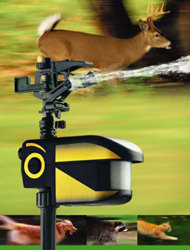





For the sake of brevity, we're not going to talk about applied repellants here. You could fill a book discussing the effectiveness of various homemade or chemical remedies designed to keep Bambi at bay.
Instead, we'll take a look at some current products on the market intended specifically for scaring birds and other creatures from your garden. Most of us love these animals and welcome them to our gardens, of course. But sometimes, birds and animals can become overly destructive to landscape plants and completely wipe out fruit and vegetable harvests. So what really works?
The first and most traditional form of is, of course, the beloved scarecrow. Nowadays, scarecrows are viewed merely as whimsical garden art, since their bird-scaring abilities have proven to be somewhat limited.
We've all seen the bobbing-head plastic owls which became very popular several years ago. Until, that is, everyone discovered they work about as well as scarecrows. Ditto for rubber snakes. (There is a $60 fake owl with outstretched, flapping wings that works somewhat better, however.)
The problem seems to be that birds, especially, are probably a little smarter than we give them credit for. (Remember when it was an insult to call someone a "birdbrain"?) Well, many birds quickly figure out that since that plastic owl or rubber snake isn't actually doing anything, such as attacking and devouring them, the present surroundings must be safe. In short, they get used to pretty much whatever stationary object you put out.
The key word here is stationary, however. Therefore, the most effective creature-scaring methods are the ones that involve constantly moving objects. Here are a few:
Terror Eyes Balloon (shown above) - This is a large orange vinyl balloon which bears the frightening face of a falcon. It moves constantly in the wind and is said to work pretty well in deterring small creatures. NASA apparently uses these to keep wild bird flocks away from the space shuttle launch areas.
Foil Tape (and Other Shiny Objects) - Another good option is iridescent foil tape strips. Some types are even printed with a crocodile-like pattern to mimic reptilian predators. Basically, though, it is the flashing that scares animals and birds. Many gardeners report similar good results with old compact discs tied to a string, or foil pie pans mounted on sticks. Again, movement is the key. An added bonus with the foil tape is that it sometimes makes a rattling sound in the breeze which also scares approaching creatures.
 Motion Detected Sound, Air, Light, or Water Blasters - These contraptions are more elaborate and expensive, but still one of the best tactics. About $100 will get you the Scarecrow Motion-Activated Sprinkler, which releases a harmless, three-second pulsating spray of water. The combination of the sudden noise, movement, and water frightens animals away. (The day will inevitable come, however, when you will walk in front of it yourself and get doused. Don't say I didn't warn you.)
Motion Detected Sound, Air, Light, or Water Blasters - These contraptions are more elaborate and expensive, but still one of the best tactics. About $100 will get you the Scarecrow Motion-Activated Sprinkler, which releases a harmless, three-second pulsating spray of water. The combination of the sudden noise, movement, and water frightens animals away. (The day will inevitable come, however, when you will walk in front of it yourself and get doused. Don't say I didn't warn you.)
Conversely, some of the sound blasters designed for chasing geese will simulate gunshots, coyote howls, hawk squawks and other predator noises. Think about that before you get one, though...do you really want to be awakened by the sound of gunfire in the middle of the night? Other sound devices will simulate the distress call of several different bird species. Still others are ultrasonic and cannot be heard by humans at all.
Laser Blasters - If you've got $1300 to burn, you can get a laser beam. This is more for professional and commercial use, obviously, but it is apparently quite effective. The green laser light flashes and scans in differing patterns to scare and temporarily disorient critters.
To sum up: keep in mind that movement is the key. Harmlessly startling the unwanted visitors is your main goal. And, no matter what device you decide to use, you will need to relocate it periodically to keep the offending animals on their toes...and off of your property.
Copyright © www.100flowers.win Botanic Garden All Rights Reserved